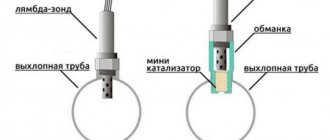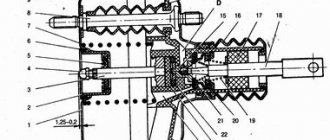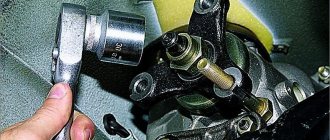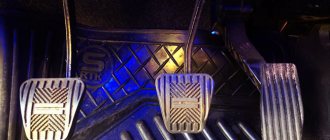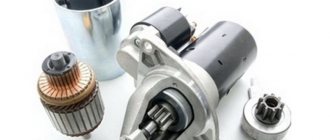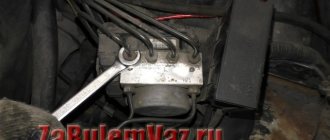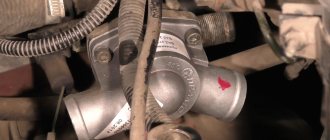When assembling modern cars, manufacturers equip vehicles with catalytic converters. These are special devices that are built into the exhaust system to remove harmful substances from exhaust gases. To make the car more environmentally friendly, the catalyst enters into chemical reactions with dangerous compounds CO, CH and NO2, as a result of which the less harmful CO2 component is released from the exhaust pipe into the atmosphere at an acceptable concentration.
Replacing the catalyst on Kalina 8 valves
A mandatory element of the exhaust system of a modern car is a catalytic converter, which ensures the neutralization (due to complete afterburning) of harmful components in the exhaust gases to a safe level of CO2 and H2O.
It is very difficult to predict the service life of a catalyst, since the durability of a given device is determined by many factors.
However, some VAZ car owners deliberately try to get rid of the catalyst as quickly as possible, in some cases, long before the end of its service life. For these purposes, special inserts are used, which are an inexpensive but very effective alternative to the catalyst.
Description and device
Their presence can damage the device and negatively affect the operation of the motor itself if it enters the combustion chamber. The engine controller reacts to this by writing an error message to the ECU memory. The first oxygen sensors were heated only by exhaust gases. The name “lambda probe” is also found. On automobile forums, many pages have long been written on the topic of what a lambda probe is and what malfunctions it has.
The sensor is located in a special hole in the exhaust manifold on a thread very close to the cylinder block. With a faulty oxygen sensor, you will not be able to legally pass a scheduled technical inspection. The car will be sent for repairs, and the ECU will put it into emergency mode, in which it will not deliver its full power potential.
- single-contact;
- two-pin;
- three- and four-pin.
The quality of the fuel, namely the presence of organometallic additives in it, directly affects the accuracy of lambda readings. These additives are the most dangerous pollutants for the oxygen sensor when forming exhaust gases.
Firmware for EURO2 and snag – what does this mean?
As I wrote above, the second oxygen sensor (lower lambda) controls harmful emissions. Their number is now strictly regulated by European standards, which are called “EURO”; I will not talk about EURO “0-1” now; we are interested in the second generation.
So, what is EURO2? It was introduced a long time ago, namely in 1996. AT that time, the cars received an innovative system, namely a catalyst. As we all know, over time it can become clogged, and the fuel then was not the same as now, it had a lot of sulfur, which contributed to the honeycombs clogging much faster, and as you and I know, the car began to choke itself. Then the engineers installed an oxygen sensor, there was only one, and it was needed to capture CO2 in the chamber in front of the catalytic converter.
If the CO2 level increased, this indirectly indicated that the catalyst was clogged (that is, a backpressure effect was manifested); the sensor sent this information to the ECU and the ignition was adjusted, namely, a decrease in the supply of the fuel mixture. Thus, the power dropped significantly, the car did not drive and the owner “willy-nilly” had to go to a service station and change this spare part.
But how? YES, everything is simple, the CO2 level in the chamber in front of the neutralizer dropped significantly, the oxygen sensor recorded this (that everything is in order) and the car drove cheerfully and without constraint. This suited everyone, BUT NOT ECOLOGISTS! Therefore, they introduced the EURO3 standard (now the EURO5 standard already exists). What has changed is that a second oxygen sensor (lower lambda) just appeared behind the catalyst. The principle of operation here is this: the first lambda (before the filter) records the level of harmful substances, the second (after it) should record a much lower level, because the harmful substances have decomposed.
What is done with firmware for EURO2? The firmware in the ECU is changed, instead of EURO3.4 standards, EURO2 standards are installed. The essence of all these actions is banal - we simply turn off the second lower lambda (only the upper one remains), the car begins to drive as expected, without underestimating the power.
But such interventions in the firmware are not entirely good. The whole point is that they don’t produce them themselves, okay, the second “lambda” is simply turned off, that is, they simply adjust the readings. Or maybe this programmer will want to put some incomprehensible algorithms into the ECU, the engine will definitely not benefit from this. You need to be very careful here.
Therefore, we found a second solution, and I think it is more correct - installing a blende. What is a snag - essentially it is a “spacer” in front of the second oxygen sensor, it seems to move it a greater distance from the exhaust gases, it detects more oxygen and starts working normally.
Now there are several options for deception:
- Empty. It's just a tube with a very thin hole at the end (the part that screws into the muffler), and an oxygen sensor is screwed into the other side. A limited amount of harmful substances from the exhaust passes through it, there are no excesses and therefore CHECK does not burn.
- With a mini catalyst inside. That is, right in the “spacer” there are, as it were, mini honeycombs, which also clean the exhaust precisely to record normal values.
- Angular. These are both of the types described above, only they are made at an angle of 90 degrees; they are needed for difficult places.
The advantages of the decoy are that you don’t need to go into the ECU and change the standard firmware, as well as the price (knocked out the cells, screwed on the decoy and that’s it, you can spend 3,000 - 5,000 rubles).
Technology for changing the catalytic converter to the 4-2-1 insert
To work, you need to prepare a set of keys for 13, 17, 19 and 22, you also need a socket head for 13 and a screwdriver with a flat blade. Parts you should purchase are two bolts with springs, a graphite connecting ring, an extension for the sensor, and a manifold gasket. Since the spider with tubes is longer than the standard neutralizer, it would not hurt to purchase a corrugation with double or triple braiding 200 mm long.
You must first remove the negative terminal from the battery. The further process of dismantling the standard part continues according to the following diagram:
- Remove the intake module using a 13mm socket, disconnect the injector wiring harness and the fuel supply hose.
- Unscrew the nuts securing the flanges of the intake pipe and catalytic converter, and then remove the pipe flange from the converter studs.
- Disconnect the oxygen sensor connectors and disconnect the wiring harness from the heat insulation shield.
- Unscrew the two nuts securing the catalytic converter bracket and remove the clamp.
To finally replace the standard catalyst on Kalina 8 valves with a modified spider, all that remains is to slide the flange off the studs and pull the assembly down. The head gasket seating areas should be cleaned.
The flange is cut off from the old catenary collector with a grinder and welded to a section of the pipe with corrugation. A snag is screwed into the sensor hole or the ECU is subsequently reflashed. These measures will get rid of the Check-Engine, and will also be cheaper than buying a new converter.
The insert is carefully inserted from above and placed on the cylinder head studs, after which the procedure for assembling the entire exhaust system is carried out. Corrugation can be excluded from the design, but its absence will significantly affect the vibration climate of the car.
Installing a spider in a 16-valve car
The sixteen-valve Kalina is equipped with a complex power supply and gas distribution system, so the work carried out will be more labor-intensive. The sequence of actions is as follows:
- removing the terminals from the battery, draining the coolant;
- loosening the clamps securing the air duct pipe and the throttle assembly to the filter;
- the pipe is removed;
- the chip is disconnected from the throttle assembly and oxygen sensor;
- the hose of the crankcase ventilation system is removed;
- the adsorber purge hose is disconnected;
- the receiver mounting bracket is unscrewed;
- the nuts are unscrewed and the receiver is removed;
- unscrew the upper and lower fastening nuts, remove the heat-insulating shield and eye;
- the fastenings of the spacer to the exhaust manifold are twisted;
- the heat shield is removed;
- the intake manifold is dismantled, for which you need to unscrew nine nuts near the block head and three at the exhaust pipe;
- “spider” is mounted;
- the lambda probe wire is extended, a mechanical or electronic snag is installed;
- The elements are assembled in the reverse order.
Replacing a catalyst is a rather complicated process. Inattention during operation can lead to damage to the vehicle's exhaust system and engine wear. Repairs should only be started if you have all the tools and replacement parts.
The catalyst prevents atmospheric pollution with carbon monoxide and other toxic substances. Its service life is not designed for more than 100,000 kilometers of vehicle mileage, so every owner will sooner or later be faced with the need to replace this element. You can replace the catalyst yourself or by contacting a service station. It is important to remember that inept DIY repairs will worsen the problem and cause additional costs in the future.
Technical features of the insert for Lada Kalina 8V
The industry offers two types of tuning inserts, the design of each of them depends on the location of the pipes. Moreover, each design is designed for a specific power unit:
- Insert 4-1 is installed on forced engines with a speed range from 5,000 to 10,000 rpm. structurally suitable only for 16-valve engines.
- The 4-2-1 insert operates over a wider range and is considered a "low-end" insert. It is possible to increase engine power by about 3-5%. This is the model most often installed on the VAZ 1118.
Since it will not be possible to install a preliminary flame arrester , you will have to carefully approach the issue of choosing an insert. The installation process of the part will not take much time if you follow all the recommendations.
What solutions to the problem does our car service offer for Lada Kalina owners?
In addition to the standard procedure for replacing a damaged catalytic converter gasket on a Kalina car with an 8-valve engine, our car service specialists offer various options for solving the problem of restoring the functionality of all parts of the exhaust system.
Before performing the described manipulations, it is necessary to determine what toxicity standards are established for a specific vehicle model.
All Kalina cars older than 2008 comply with the Euro-3 environmental standard, that is, the design of their exhaust system includes two parallel lambda probes.
Before removing the neutralizer, our service center specialists must agree with the owners on the following points:
- The converter blend with the exhaust manifold will form a single structure.
- The use of a special blende is justified by the occurrence of high resonance in the exhaust system. Therefore, installing the insert will help to significantly reduce the noise level.
- In Kalina models that comply with Euro-2 standards (that is, produced before 2008), after installing the blende, you need to completely redo the lambda wiring and the junction of the collector with the resonator.
- On models adapted for Euro-3, after installing a special insert to ensure correct operation of the power unit, the ECU firmware will need to be changed.
Recommendations
Comments 68
with eight valves the spider is of little use. take a regular insert, tested from personal experience
I unscrewed the catalytic converter, cut off the ears with a grinder and welded them to a simple pipe made of stainless steel exhaust drain, only everything was empty! I didn’t worry about the firmware and it didn’t catch fire! True, I had a catalytic converter after the spider
You can use a snag But it’s better to flash it under Euro-2
Order a spider for two oxygen sensors! We can do that. The second one will be through a mechanical fuse right away (a sleeve like this goes under the second one). And don't forget to order two oxygen sensor extensions. If you have any more questions, I will answer in PM.
flashing in any case, the difference will be noticeable, don’t worry, I’m telling you as a diagnostician
Good evening, Alexander. I ask for advice as a diagnostician. I have a viburnum 8 class, 1.6, EURO-2. Three years ago, instead of the catalytic collector, I installed a dummy and after that, periodically, one might even say, the error “no DC activity” began to light up periodically, I installed a new oxygen sensor, everything is the same. Do I need to reflash it for Euro-0?
It is possible under Euro-0, but the consumption will be slightly higher. It’s better to flash it under Euro-2 or edit your own, or better yet, online firmware!
Read also: Fuel pump on gazelle 406 injector does not work
It’s easier to install an insert to replace the 4-1 catalyst, there’s no need for any screws, everything is done right for the second sensor, but the first one needs to be extended anyway.
why install a spider? want to achieve an increase in power?
no, I just want to throw away the catalyst to hell and install a stainless steel spider
why install a spider? want to achieve an increase in power?
no, you need durability
Then I don’t see the point in a spider, to be honest)) set the factory and the jacks won’t light up and it will drive as it did)
thanks, we'll do that
sewing of course! otherwise what's the point!)
the spider in the picture is crap. Search with as long pipes as possible until they converge into 2 or 1 pipe.
stainless steel only this option
try looking again, with a short length of pipes, the gases from the cylinders will interfere with each other, the longer the length before the pipes come down, the less this negative effect. Don't waste your money on an ill-conceived spider
Well, it’s like they don’t complain about them
Well, of course, if people didn’t know the best options, then this spider will seem very good compared to a standard catalyst) but you can get even greater output from the engine
Well, it’s like they don’t complain about them
Here, watch my video
did the same job
If there is only one sensor in the car and there is one hole on the spider, then change it and drive. you don’t need to sew anything, the principle of lambda operation remains the same
If there is only one lambda, then everything will be ok
damn, still 2 in progress
I have one) and everything works ok)
damn, still 2 in progress
I have it before the catalytic converter
If Euro-3, then there should be two sensors. The main one is the one before the catalyst. It regulates the composition of the mixture. If you don't want to flash it, you can't delete it. But there is room for it in the spider. You just put it in the spider and that's it. You may need an extension cord for the wires to the sensor. The second sensor on the Euro-3 engine serves only to monitor the efficiency of the converter. If you don’t install it, the dzhekichan will light up, but it won’t have much of an effect on driving. I’ve been riding like this for a couple of months now, the consumption and dynamics are normal. The brains of the Bosch MP7.0. There are two errors on DK 2 (one has already been successfully removed without firmware). Well, if you have only one sensor, then don’t worry at all - take it and put a spider with a nut under the sensor and ride to your health. And without the firmware it won’t swear at anything
errors 0136 and 0140?
0140 and 0141. 0140 (open circuit DK2) was removed by connecting a 100 KOhm decoy resistor. Brains don't swear anymore. And 0141 is a heater break; it is more difficult to simulate. I have an old-style DC, its heater resistance is small (about 3 ohms), and therefore, if you just hang a 3 ohm resistor, a lot of power is dissipated on it and it gets really hot. You need a very powerful resistor and a good heat sink. Therefore, I’ll probably just hang the old sensor with a working heater somewhere near the exhaust system. And then I plan to programmatically get rid of DK2
If Euro-3, then there should be two sensors. The main one is the one before the catalyst. It regulates the composition of the mixture. If you don't want to flash it, you can't delete it. But there is room for it in the spider. You just put it in the spider and that's it. You may need an extension cord for the wires to the sensor. The second sensor on the Euro-3 engine serves only to monitor the efficiency of the converter. If you don’t install it, the dzhekichan will light up, but it won’t have much of an effect on driving. I’ve been riding like this for a couple of months now, the consumption and dynamics are normal. The brains of the Bosch MP7.0. There are two errors on DK 2 (one has already been successfully removed without firmware). Well, if you have only one sensor, then don’t worry at all - take it and put a spider with a nut under the sensor and ride to your health. And without the firmware it won’t swear at anything
Euro-3 - two recreation centers. Put a decoy instead of 2 DK. The internet is full of diagrams.
That's what I did to myself. All that remains is to clear the error about the heater breakage
why is everything so complicated to remove the catalyst, the stinger simply has a replacement for it stinger-shop.ru/index.php…irtuemart_category_ >
I need it in stainless steel
why is everything so complicated to remove the catalyst, the stinger simply has a replacement for it stinger-shop.ru/index.php…irtuemart_category_ >
Well, in your photo the spider has a 4-1 format, while the top starter has a 4-2-1, the difference is significant.
why is everything so complicated to remove the catalyst, the stinger simply has a replacement for it stinger-shop.ru/index.php…irtuemart_category_ >
Insert for replacing the catalyst “Stinger” 4-1 16V 1.6L (two oxygen sensors) “16V” doesn’t confuse you?
fell asleep, slipped up sometimes)))
On Euro-3 there are 2 DCs, the first before the catalyst, the second after. The first affects consumption and is the main one, the second is for controlling the catalyst. It is better to put the first one in a new place, where one pipe begins (pick up a nut, drill from the side and weld it), but due to the fact that this is quite far from the engine and at the very bottom, and the DC starts working only when it warms up to In any case, 350 degrees must be installed with heating, usually 2 gray or white wires and there is heating, one for ground, the second for 12V, which appears with on. ignition Instead of the second recreation center they put a decoy. The internet is full of diagrams.
Untimely gasket replacement: dangers and risks
The main danger lies in the excessive formation of carbon deposits and its deposition on the exhaust system channels. The second point: ceramic honeycombs are destroyed over time, their fragments are spread under pressure throughout the entire system. This is very dangerous, since the particles block circulation and contribute to damage to internal mechanisms: timing belt, spark plugs. The most dangerous option is when fragments of ceramic honeycomb penetrate the oil pan and mix with the engine oil. Subsequently, this mixture damages the surface of the cylinder walls. The car loses compression, breaks down, and needs partial or major repairs.
Sale of spare parts and repair of muffler in St. Petersburg tel.: +7 (812) 336-43-32
Catalyst (catalytic converter) - is a metal body (in the form of a “can”), coated on the inside with a layer of refractory material in the form of numerous honeycombs.
The main symptoms of malfunction of this element are: a decrease in engine power and, as a consequence, the dynamic capabilities of the car; the “Check Engine” sign turns on (engine ECU error: “low catalyst efficiency”). Possible breakdowns may include blockage of the cells or their melting, or melting or rupture of the wires of the oxygen level sensors. Unfortunately, catalysts cannot be repaired in any way; for this reason, it is almost always necessary to remove it from the system and install a blende in its place. It is possible to replace the catalyst, but the high cost of this element repels almost everyone.
Almost all modern electronic engine control systems are equipped with numerous detectors that monitor the composition of the fuel mixture. Oxygen detectors (lambda probes) always operate in tandem with a catalyst, and two sensors are usually installed in the system:
The first of them is mounted in front of the “catalyst can”; its task is to change the fuel supply depending on conditions and send a signal to the engine ECU; The second lambda probe is inserted into the system after the catalyst and serves to determine the qualitative composition of the combustion products of the fuel mixture. If a catalyst is excluded from such a gas exhaust system, then the content of toxic elements in the combustion products of the fuel mixture will be higher than normal, and the diagnostic sensor will give a signal about excess CO in the exhaust tract. The engine ECU will receive the signal and inform the driver about the error - after the catalyst is ejected from the gas exhaust system, the Check Engine light will turn on on the instrument panel.
Removing the catalyst. Pros and cons, consumption, firmware - we reveal all the secrets
Often my blog (and my channel) receives a lot of questions regarding the catalyst, and some readers still have many misconceptions in their heads. One of them (for example) is that if you remove this part of the muffler, then it will be VERY bad for the car, it will literally stand up and refuse to go! I decided to answer all the questions at once, so today we will talk: - is it worth removing it or not (what are the pros and cons of such manipulation), what will be the consumption after cutting it out, is it necessary to flash the ECU (and what are the risks), and well a few words about “deception”. In general, it will be interesting, as usual, the video version at the end...
At the very beginning, I would like to say that this unit is NOT SOMETHING IMPORTANT for the car, but now “a bunch of stones” will fly at me, they say, what are you saying, but what about ECOLOGY? But if we put aside all the exclamations of the “greens”, then a car without a catalyst will work BETTER, CONSUMPTION will be lower, and the POWER will increase a little.
Why do you need a catalyst?
I already have an article - what is it , I won’t repeat it. You need to understand that a catalyst (and scientifically, a catalytic converter) is needed only to clean the car's exhaust from harmful emissions and make them less harmful.
In simple words, it purifies harmful gases (while glowing almost “red hot”) and “almost” harmless CO2 and N2, O2 emerge from harmful CO, CH and other compounds. This way we save the environment at least a little.
Its structure is quite simple - it is a thickened pipe, which inside has something like a honeycomb, only long and hollow. They are usually made of ceramic elements coated with noble metals (usually platinum group metals are used - iridium, rhodium, palladium).
It is because of this that it costs, to put it mildly, quite a bit, from 30 to 150,000 rubles, it all depends on the class of the car and its volume.
In order for gases to transform from toxic to less harmful, the temperature of the catalyst must be about 750 degrees Celsius, otherwise the chemical reaction will not occur. The gases that come out of a car engine have a temperature of approximately 500 - 550 degrees Celsius (which is not enough), when they pass through the catalyst, a chemical reaction occurs with the release of heat, thus heating just the right amount (750 - 900 degrees).
The catalytic converter is knocked out, is this bad for the car?
As I wrote above, this is simply an environmental system, and if it is not there, then the car, on the contrary, will improve its characteristics (power, consumption). To put it simply, initially the engine doesn’t care about this converter, but it creates an obstacle in the muffler, overcoming which takes part of the engine’s energy (more on this below).
But why on many cars, if this unit fails (say, melted, clogged or crumbled), the CHECK ENGINE and the car begins to behave abnormally, traction disappears, sometimes it trots a little, and simply may not start at all.
And here, friends, everything is simple. If the catalyst is melted or clogged, then the exhaust gases cannot pass through it normally, which means that some returns back into the combustion chamber and makes the newly introduced combustible mixture less efficient. The motor is choking itself.
If there is no melting, but the “CHECK” light comes on, then perhaps it has simply worn out due to high mileage. In modern cars there are so-called oxygen sensors (lambda umbrellas), one is located in front of the catalyst, the other after and detects the presence of harmful compounds; if their percentage has increased, then the second (or also called the lower “lambda”) gives a signal that the converter is not working ( or it doesn’t do its job as it should) AND IT NEEDS TO BE REPLACED. By the way, some cars may not even start (a tribute to the environment).
Thus, by knocking out or removing it, you simply free the car’s exhaust tract from the obstacle in the form of a filter and lower its environmental standards. BUT AGAIN - THIS DOES NOT AFFECT THE RESOURCE OF THE POWER UNIT !
How to determine the malfunction of the Lada-Kalina muffler
To find a faulty exhaust system, you don’t have to be a car mechanic or have extensive experience in car repairs. To identify problems, you need to act in the following sequence:
- Pay attention to noises that are made while driving. If the muffler is faulty, the sound will be quite loud. Extraneous noises also indicate problems with the exhaust system.
- Raise the car with a jack or drive onto an overpass and inspect the system body. A working device should have no holes or rust. The presence of traces of corrosion indicates that, most likely, there is a problem with the housing.
- While driving, you need to monitor the color of the exhaust: the periodic appearance of black and dense smoke will indicate that there are problems with the exhaust system.
- Start the engine and press the gas pedal for several minutes. Then turn off the ignition and check the engine temperature. During this time it should not get very hot. If it has risen significantly, it means that there are problems in the performance of the mechanism.
Summary
According to some motorists, after tuning the car becomes faster, there is no hysterical roar when the revolutions approach 5,000. The exhaust sound has also changed, it has become more pleasant. In most cases, there is a decrease in fuel consumption. The financial component is also very noticeable - installing a 4-2-1 spider costs at least half as much.
So. Resonator. They lifted the car. We examined it. 1. The triangular flange that the welder welded for me last time was on site. welding is intact. 2. The corrugation on the resonator is full of holes. Here we could probably limit ourselves to replacing the corrugation, or the resonator, as you prefer. But I was sure that the pipes to the 1st and 4th pots at the resonator were cracked because... traces were visible that gases were escaping there. And judging by the state of the triangular flange, I am sure that it will burst again a little further where the new weld ends. The guys did not disassemble half the engine. They did not remove the fuel rail. They did not remove the throttle. And thanks to them for that too. The less there is to disassemble, the better, at least it makes me feel better. They unscrewed all the nuts from the manifolds, disconnected the wires, hoses and simply moved it to the side. And then it began to flow... Literally... the expansion tank was empty. But what bothered me more was that everything flowed into the cylinders because... antifreeze was not drained. A little leaked out... not a lot, I don’t know how much got into the pots (
The car is 9 years old, all the nuts have been unscrewed, nothing seems to be broken. Here is the catalyst:
In principle, it was possible to weld the cracks... but for this you still need to remove it... and something tells me that it would burst again, and to cook again means removing it again... But the state of the honeycomb in my catalyst: (This is a photo from the side of the triangular flange , i.e. gas escape)
But on the engine side, i.e. where the gases enter
As you can see, everything is in order. It turns out that I am replacing an expensive spare part with a working catalytic element, and it is this that makes up almost the entire cost of this spare part, only because someone designed the body with their hands growing out of their ass. Bitches... no words... just a shame.
Marked AR 11183-1203008 11 2015 By the way, this service had a promotion and a new catalyst cost me 6500 rubles) You can of course find it for example for 6350, but usually the price in the store is around 7000.7500 As you can see, it’s almost the same, the difference is that the new one has thread for the second DC and instead of three studs on the triangular flange there are three threaded holes. On the old catalyst, the hole for the second DC was welded. On the new one, “Welder” also welded a hole for the second recreation center.
“The Welder” suggested drilling three holes, I also wanted to tell him this, but he beat me to it) Here I would like to say a message to AvtoVAZ: Gentlemen, stop messing with the studs and threaded holes on this flange. Don’t you understand that all this will simply not be unscrewed in a few years. Just make three holes for regular bolts. Pad:
Of course, this is also a perversion... Firstly, antifreeze. There are channels in the head that go to the plane of the gasket, there are no channels in the intake manifold, there are no holes in the gasket, I marked these places with red arrows. In general, either everything was done to complicate the repair, or at AvtoVAZ back in 1984 a turbo engine was already designed and all the block heads were immediately manufactured with a reserve for the future, having made heads in reserve so that they would last for the next 30 years, so now they are installing them... By the way, I have on a working machine, the turbine on the engine has no connection with antifreeze at all, oil is supplied through one tube, oil flows through the other into the engine crankcase, and all this has been working perfectly for 7 years, 12 hours a day. Secondly: what prevented you from making two separate gaskets for the intake and exhaust manifolds? There are plenty of attachment points. There are thermal cuts between the inlet and outlet channels, so separate the gaskets and then maybe the pelvis pipes will forgive you for the perversion with the outlet of the cooling system channels to the plane of the gasket. The catalytic converter is in place, the intake manifold is in place. tubes, wires. Now the corrugation: Here it is:
Something tells me that 1 year of service is not enough for this part. A new resonator (catalog number 11180-1200020-20) costs about 2,500 rubles (You can find it for 950 rubles, but it will be without corrugation). Cutting out the corrugation and welding a new one in its place costs about the same money as buying and installing a new resonator. Conclusion: it makes sense to buy a new one if the resonator comes to an end. Although I saw it for 1300 rubles with a vibration compensator (corrugation). If you want to buy a Transmaster resonator, think again. Mine only lasted a year! just one year! Yes, my original resonator ran for 8 years and not a single crack in the corrugation. The pipe fell off the can, yes, but the corrugation held up perfectly. The corrugation on the Transmaster resonator is weak. Speaking of the clamp... Yes, yes, the catalyst is also attached to the engine with a clamp. He happily rotted:
Errors and malfunctions, sensor maintenance
To check the heater circuit, you need to turn off the ignition, disconnect the harness connector from the controller and check contact X1/C4 by connecting it to the vehicle's on-board network. If a short circuit does not occur, then the controller is faulty. If there is, you need to disconnect the UDC block and check the closure of its contact D. If present, you need to check the wiring harness; if not, the UDC has failed.
When the harness, block or plug of the lambda probe is damaged, the only solution is to replace it. The oxygen sensor must be in contact with ambient air. For this purpose, special gaps are made between the probe wires, which can be easily damaged if repairs are undertaken.
Monitor the condition of the sealing pad on the outer surface of the sensor and prevent it from being damaged. To remove the lambda, turn off the ignition, disconnect the wiring harness from the probe, and carefully unscrew the device itself using a 22mm wrench. The procedure for installing a new sensor is described in the next section. The new lambda requires careful handling during installation to avoid contamination and damage.
The Check Engine on the dashboard may not light up, but if you notice increased fuel consumption and unstable engine operation, or that the engine is not reaching its maximum power, this is an indicator of failure of the UDC. If the Check Engine lights up, the ECU averages the engine settings, and it will no longer be possible to use it to its full potential - you need to go to a service center for diagnostics.
Chip tuning of Lada Kalina engine
The Hephaestus car service has all the necessary equipment, including official programmers and system applications, for downloading, editing and installing new firmware of the leading electronic engine control unit on LADA. With us, unlike most other car services in Moscow, Lyubertsy, Zhukovsky or Ramensky, you can order a full-fledged chip tuning of your car, which will be performed both at the physical and software levels.
We provide a quality guarantee for repairs of both the engine and exhaust system!
Removing the catalyst
To forget about the loss of traction in the engine, the delay of exhaust in the catalyst, we will change the ECU settings (we will flash the ECU), and also physically remove the unusable catalysts from the exhaust pipe of the Lada Kalina.
All these services are large-scale, but we perform chip tuning of Lada Kalina literally in one day, we carry out all work on this service with 100% high quality, accurately and taking into account the technical features of the model.
ECU firmware
Having physically removed the catalyst on the Lada Kalina, we will complete the procedure for optimizing the operation of the exhaust system at the software level - and disable scanning of the second oxygen sensor in the system. In simpler terms, through the ECU firmware we will disable the lambda probe of the Lada Kalina.
Exhaust system "Lada Kalina"
After processing the air-fuel mixture, residual substances must be released from the engine cavity. An exhaust system is used for these purposes. Without it, operating any car is simply impossible.
The exhaust system of the Lada Kalina car consists of several elements:
- an exhaust manifold;
- exhaust pipe;
- main muffler;
- additional;
- catalytic converter.
All parts of the exhaust system not only allow you to safely and quickly remove exhaust gases from the engine, but also reduce noise levels . And the neutralizer serves to reduce carbon monoxide emissions, that is, it reduces the toxicity of exhaust on the Lada Kalina.
It should be noted that the mufflers for Lada Kalina sedans, hatchbacks and station wagons will be slightly different. Thus, the device labeling must fully comply with the VAZ labeling. For example, VAZ-1117 (Lada Kalina hatchback) requires model 1117, and VAZ-1118 (Lada Kalina sedan) requires muffler 1118. For the Lada Kalina station wagon modification, a device marked 1118-1200010 is installed.
